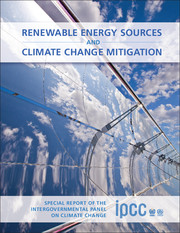 Renewable Energy Sources and Climate Change Mitigation
Renewable Energy Sources and Climate Change Mitigation Book contents
- Frontmatter
- Contents
- Section I
- Section II
- Section III
- Chapter 1 Renewable Energy and Climate Change
- Chapter 2 Bioenergy
- Chapter 3 Direct Solar Energy
- Chapter 4 Geothermal Energy
- Chapter 5 Hydropower
- Chapter 6 Ocean Energy
- Chapter 7 Wind Energy
- Chapter 8 Integration of Renewable Energy into Present and Future Energy Systems
- Chapter 9 Renewable Energy in the Context of Sustainable Development
- Chapter 10 Mitigation Potential and Costs
- Chapter 11 Policy, Financing and Implementation
- Section IV
- Index
- References
Chapter 1 - Renewable Energy and Climate Change
Published online by Cambridge University Press: 05 December 2011
- Frontmatter
- Contents
- Section I
- Section II
- Section III
- Chapter 1 Renewable Energy and Climate Change
- Chapter 2 Bioenergy
- Chapter 3 Direct Solar Energy
- Chapter 4 Geothermal Energy
- Chapter 5 Hydropower
- Chapter 6 Ocean Energy
- Chapter 7 Wind Energy
- Chapter 8 Integration of Renewable Energy into Present and Future Energy Systems
- Chapter 9 Renewable Energy in the Context of Sustainable Development
- Chapter 10 Mitigation Potential and Costs
- Chapter 11 Policy, Financing and Implementation
- Section IV
- Index
- References
Summary
Executive Summary
All societies require energy services to meet basic human needs (e.g., lighting, cooking, space comfort, mobility, communication) and to serve productive processes. For development to be sustainable, delivery of energy services needs to be secure and have low environmental impacts. Sustainable social and economic development requires assured and affordable access to the energy resources necessary to provide essential and sustainable energy services. This may mean the application of different strategies at different stages of economic development. To be environmentally benign, energy services must be provided with low environmental impacts and low greenhouse gas (GHG) emissions. However, 85% of current primary energy driving global economies comes from the combustion of fossil fuels and consumption of fossil fuels accounts for 56.6% of all anthropogenic GHG emissions.
Renewable energy sources play a role in providing energy services in a sustainable manner and, in particular, in mitigating climate change. This Special Report on Renewable Energy Sources and Climate Change Mitigation explores the current contribution and potential of renewable energy (RE) sources to provide energy services for a sustainable social and economic development path. It includes assessments of available RE resources and technologies, costs and co-benefits, barriers to up-scaling and integration requirements, future scenarios and policy options.
GHG emissions associated with the provision of energy services are a major cause of climate change. The IPCC Fourth Assessment Report (AR4) concluded that “Most of the observed increase in global average temperature since the mid-20th century is very likely due to the observed increase in anthropogenic greenhouse gas concentrations.”
- Type
- Chapter
- Information
- Renewable Energy Sources and Climate Change MitigationSpecial Report of the Intergovernmental Panel on Climate Change, pp. 161 - 208Publisher: Cambridge University PressPrint publication year: 2011
References
- 26
- Cited by


